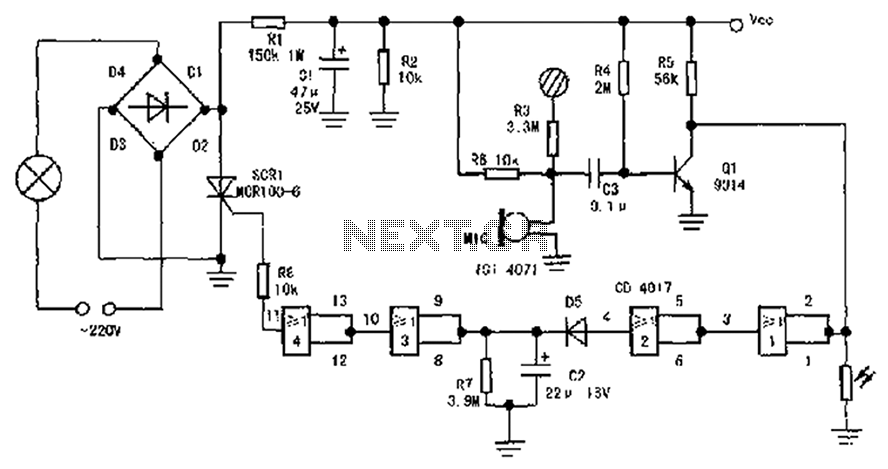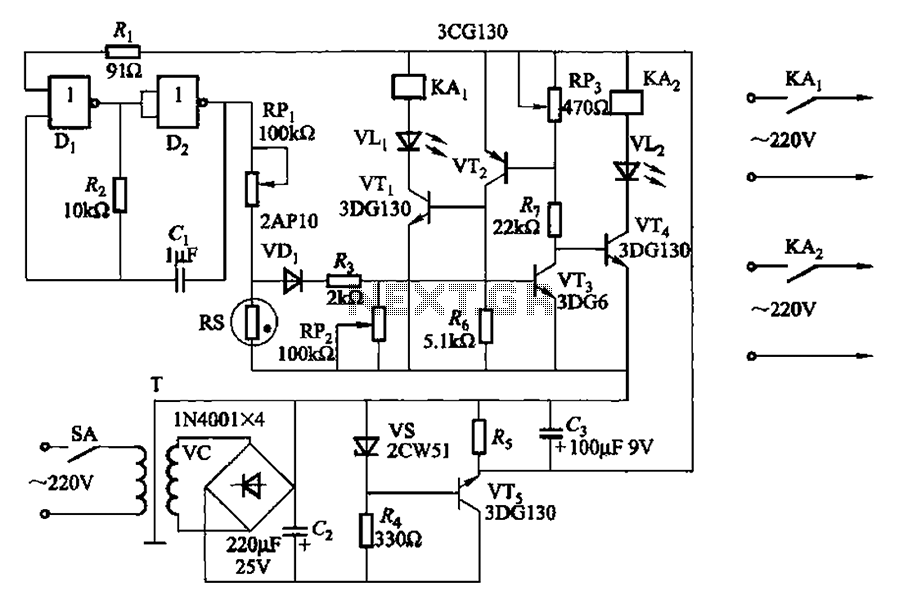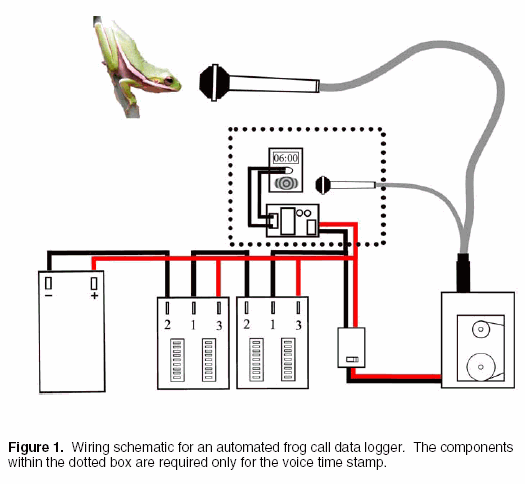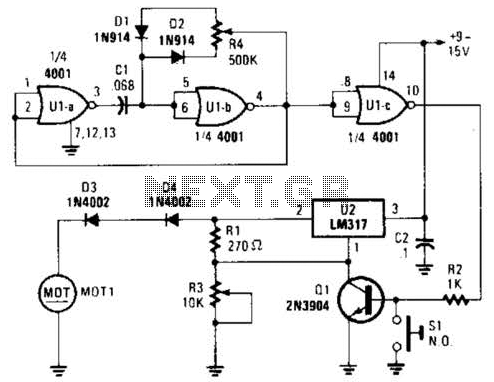
remote control using the ne 555 and lm 567
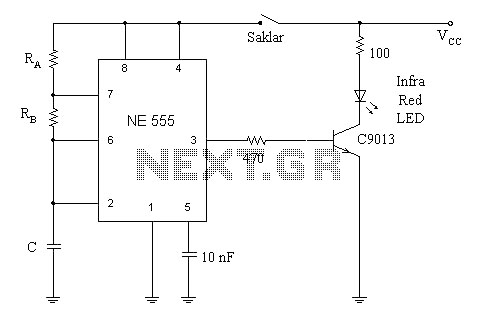
A simple circuit diagram illustrates a schematic for a remote control system, which consists of two components: a transmitter and a receiver. The transmitter circuit is controlled by the NE555 integrated circuit (IC). This system operates by detecting the emitted frequency signal. For the transmitter circuit (NE555, or alternatively, the LM567 as a frequency generator) to function correctly, the frequency it generates must match the frequency of the decoder. The schematic for the transmitter is provided. To facilitate tuning, R1 is a variable resistor in the receiver, while the transmitter uses a fixed value resistor. Once the circuit is prepared, the first step is to tune the system by continuously powering the transmitter while adjusting R1 in the receiver to detect the transmitter's signal (indicated by the relay's click). The second component is the receiver circuit, which is controlled by the LM567. A schematic for the receiver is also included. Each channel in the design is set to a different frequency, and it is important to ensure that the frequency channels have a sufficient separation, typically around 5 kHz, to accommodate the bandwidth of the LM567's frequency detection capabilities.
The remote control system consists of a transmitter and a receiver, each designed to operate on specific frequencies. The transmitter employs the NE555 timer IC, which is configured in astable mode to generate a square wave signal at a desired frequency. Alternatively, the LM567 can be used as a frequency generator to achieve similar results. The frequency output of the transmitter must be precisely matched to the frequency input of the receiver to ensure effective communication.
In the receiver circuit, the LM567 is utilized as a tone decoder, which is sensitive to the frequency generated by the transmitter. The variable resistor R1 allows for fine-tuning of the receiver's sensitivity to the incoming signal. By adjusting R1, the user can optimize the receiver's ability to detect the transmitter's signal, which is verified by the activation of a relay. This relay serves as an output mechanism, indicating successful reception of the signal.
The design of the remote control system includes multiple channels, each operating at different frequencies to prevent interference. It is essential to maintain a frequency separation of at least 5 kHz between channels to ensure that the LM567 can effectively distinguish between them. This careful consideration of frequency management allows for reliable operation of the remote control system in various applications, such as controlling electronic devices or systems wirelessly. The overall schematic design should be carefully laid out to facilitate easy assembly and troubleshooting, ensuring that all components are correctly connected and that the circuit functions as intended.Simple circuit diagram is a schematic remote control, remote control where it consists of two parts of the transmitter and receiver. The first part is a transmitter, circuit diagrams for transmitter IC is controlled by the NE555. This system works by detecting the signal emitted frequency. Frequency signal so that the transmitter circuit (NE 555, can also use the LM 567 as a generator frequency) must be equal to the frequency decoder. The following is a schematic remote control drawing transmitter: To facilitate the process of tunning, the R1 is a resistor in the receiver variable. While the transmitter is a fixed value. When the circuit is ready, so the system works well, the first step taken is to tunning, by way of the transmitter is turned on continuously, while the receiver R1 to set the value to be able to detect the signal transmitter (can be determined by the reaction of the relay is clicked).
For the second part is a circuit diagram of the receiver, the receiver is controlled by the LM567. The following is a schematic remote control drawing receiver: In the picture on top of each channel is designed with a different frequency. By considering the bandwidth of the frequency detection signal LM 567, inter-frequency channels should have a big enough difference, let`s try remote control with a difference of 5 KHz.
🔗 External reference
The remote control system consists of a transmitter and a receiver, each designed to operate on specific frequencies. The transmitter employs the NE555 timer IC, which is configured in astable mode to generate a square wave signal at a desired frequency. Alternatively, the LM567 can be used as a frequency generator to achieve similar results. The frequency output of the transmitter must be precisely matched to the frequency input of the receiver to ensure effective communication.
In the receiver circuit, the LM567 is utilized as a tone decoder, which is sensitive to the frequency generated by the transmitter. The variable resistor R1 allows for fine-tuning of the receiver's sensitivity to the incoming signal. By adjusting R1, the user can optimize the receiver's ability to detect the transmitter's signal, which is verified by the activation of a relay. This relay serves as an output mechanism, indicating successful reception of the signal.
The design of the remote control system includes multiple channels, each operating at different frequencies to prevent interference. It is essential to maintain a frequency separation of at least 5 kHz between channels to ensure that the LM567 can effectively distinguish between them. This careful consideration of frequency management allows for reliable operation of the remote control system in various applications, such as controlling electronic devices or systems wirelessly. The overall schematic design should be carefully laid out to facilitate easy assembly and troubleshooting, ensuring that all components are correctly connected and that the circuit functions as intended.Simple circuit diagram is a schematic remote control, remote control where it consists of two parts of the transmitter and receiver. The first part is a transmitter, circuit diagrams for transmitter IC is controlled by the NE555. This system works by detecting the signal emitted frequency. Frequency signal so that the transmitter circuit (NE 555, can also use the LM 567 as a generator frequency) must be equal to the frequency decoder. The following is a schematic remote control drawing transmitter: To facilitate the process of tunning, the R1 is a resistor in the receiver variable. While the transmitter is a fixed value. When the circuit is ready, so the system works well, the first step taken is to tunning, by way of the transmitter is turned on continuously, while the receiver R1 to set the value to be able to detect the signal transmitter (can be determined by the reaction of the relay is clicked).
For the second part is a circuit diagram of the receiver, the receiver is controlled by the LM567. The following is a schematic remote control drawing receiver: In the picture on top of each channel is designed with a different frequency. By considering the bandwidth of the frequency detection signal LM 567, inter-frequency channels should have a big enough difference, let`s try remote control with a difference of 5 KHz.
🔗 External reference
